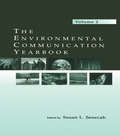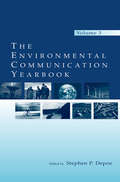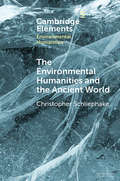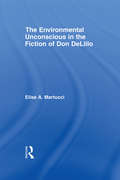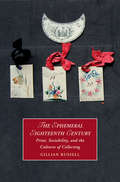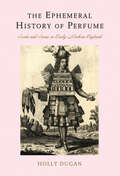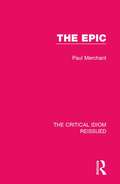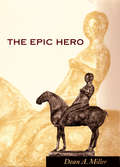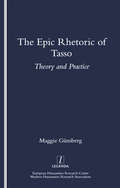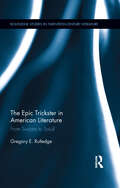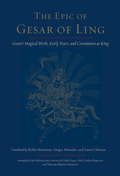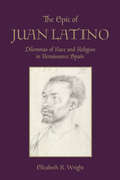- Table View
- List View
The Entrapments of Form: Cruelty and Modern Literature
by Catherine ToalArguing that cruelty acquires a new meaning in modernity, The Entrapments of Form follows its evolution through exchanges between French and American literature over the contradictions of Enlightenment (slavery, genocide, libertine aristocratic privilege). Catherine Toal traces Edgar Allan Poe’s influence on the Sadean legacy, Melville’s fictional dramatization of Tocqueville, and Henry James’s response to the aesthetic of his French contemporaries, including Flaubert. The result is not simply a work that provides close readings of key literary texts of the nineteenth century—Benito Cereno, The Turn of the Screw, Les Chants de Maldoror—but one that shows how in this era cruelty develops a specific narrative structure, one that is confirmed by the manner of its negation in twentieth-century philosophy. The final chapters address this shift: the postwar French reception of Sade and the relationship between American cultural theory and the rhetoric of the so-called war on terror.
The Entrepreneurial Journalist’s Toolkit: Manage Your Media
by Sara KellyToday's journalism and communication students need the tools to develop and maintain their own media businesses and freelance careers. In addition to mastering the basics of converged journalism practice, they need training in business entrepreneurship, mass communication and business law, and career and reputation management. The Entrepreneurial Journalist's Toolkit provides a solid foundation of multimedia journalism and also teaches readers to create solid business plans and develop funding proposals while maintaining high legal and ethical standards. This book details the process of pitching and working with clients, managing multi-platform communication campaigns to maximize reach, keeping the books, and filing taxes. It is provides everything a new or experienced journalist needs to get started as a media entrepreneur.
The Environment in Brazilian Culture: Literature, Cinema, and the Arts
by Patricia VieiraExamining Brazilian artists’ engagement with the natural world from 1900 to the present The Environment in Brazilian Culture explores the centrality of the natural world in shaping Brazilian literature, cinema, and art since 1900. This collection, exceptional in its representation of material from diverse locations and cultures within Brazil, as well as in its investigation of a range of artistic mediums and genres, portrays the human connection to nature in the most biodiverse country in the world. From the forests of the Amazon to the mountains of the Serra do Mar, this volume examines Brazilian depictions of different geographical regions and the plants and animals found in each. Contributors pay particular attention to the environment’s integral place in Indigenous identity and art. They also discuss artistic references to environmental devastation, underscoring the connection between ecological degradation and contemporary socioeconomic inequality. Works discussed in these chapters include novels by Itamar Vieira Junior and Maria José Silveira, poetry by Marília Floôr Kosby, Guarani and Bororo verbal arts, Huni Kuĩ documentary films, and paintings by Candido Portinari.These wide-ranging analyses highlight the value of Brazilian cultural production to critical plant and animal studies, posthumanism, and the environmental humanities. And, in grappling with Brazil’s extractivist past, they search for alternatives to a predatory approach to the land and its inhabitants, looking for pathways to environmental justice in the Anthropocene. Contributors: Victoria Saramago | Leila Lehnen | Rex P. Nielson | Maria Esther Maciel | Valeria Meiller | Benjamin Burt | Juliana Luna Freire | Nuno Marques | Cinthya Torres | Jens Andermann | Malcolm K. McNee | Patricia Isabel Lontro Marder Vieira | Martiniano Alcantara Neto
The Environment on Stage: Scenery or Shapeshifter? (Routledge Studies in World Literatures and the Environment)
by Julie HudsonThe Environment on Stage: Scenery or Shapeshifter? investigates a pertinent voice of theatrical performance within the production and reception of ecotheatre. Theatre ecologies, unavoidably enmeshed in the environment, describe the system of sometimes perverse feedback loops running through theatrical events, productions, performances and installations. This volume applies an ecoaware spectatorial lens to explore live theatre as a living ecosystem in a literal sense. The vibrant chemistry between production and reception, and the spiralling ideas and emotions this generates in some conditions, are unavoidably driven by flows of matter and energy, thus, by the natural environment, even when human perspectives seem to dominate. The Environment on Stage is an intentionally eclectic mix of observation, close reading and qualitative research, undertaken with the aim of exploring ecocritical ideas embedded in ecotheatre from a range of perspectives. Individual chapters identify productions, performances and installations in which the environment is palpably present on stage, as it is in natural disasters such as floods, storms, famine, conflict and climate change. These themes and others are explored in the context of site-specificity, subversive spectators, frugal modes of narrative, the shifting ‘stuff’ of theatre productions, and imaginative substitutions. Ecotheatre is nothing less than vibrant matter that lets the environment speak for itself
The Environmental Communication Yearbook: Volume 1
by Susan L. SenecahEditorial ScopeThe Environmental Communication Yearbook is a multidisciplinary forum through which a broad audience of academics, professionals, and practitioners can share and build theoretical, critical, and applied scholarship addressing environmental communication in a variety of contexts. This peer-reviewed annual publication invites submissions that showcase and/or advance our understanding of the production, reception, contexts, or processes of human communication regarding environmental issues. Theoretical expositions, literature reviews, case studies, cultural and mass media studies, best practices, and essays on emerging issues are welcome, as are both qualitative and quantitative methodologies. Areas of topical coverage will include:*participatory processes: public participation, collaborative decision making, dispute resolution, consensus building processes, regulatory negotiations, community dialogue, building civic capacity;*journalism and mass communications: newspaper, magazine, book and other forms of printed mass media; advertising and public relations; media studies; and radio, television, and Internet broadcasting; and*communication studies: rhetorical/historical case studies, organizational analyses, public relations/issues management, interpersonal/relational dimensions, risk communication, and psychological/cognitive research, all of which examine the origins, content, structure, and outcomes of discourse about environmental issues. Submissions are accepted on an ongoing basis for inclusion in volumes published annually. AudienceResearchers, scholars, students and practitioners in environmental communication, journalism, rhetoric, public relations, mass communication, risk analysis, political science, environmental education, environmental studies, public administrations; policymakers; others interested in environmental issues and the communication channels used for discourse and information dissemination on the topic.For more information and guidelines for submissions, visit www.erlbaum.com/ecy.htm.
The Environmental Communication Yearbook: Volume 2
by Susan L. SenecahEditorial ScopeThe Environmental Communication Yearbook is a multidisciplinary forum through which a broad audience of academics, professionals, and practitioners can share and build theoretical, critical, and applied scholarship addressing environmental communication in a variety of contexts. This peer-reviewed annual publication invites submissions that showcase and/or advance our understanding of the production, reception, contexts, or processes of human communication regarding environmental issues. Theoretical expositions, literature reviews, case studies, cultural and mass media studies, best practices, and essays on emerging issues are welcome, as are both qualitative and quantitative methodologies. Areas of topical coverage will include:*participatory processes: public participation, collaborative decision making, dispute resolution, consensus building processes, regulatory negotiations, community dialogue, building civic capacity;*journalism and mass communications: newspaper, magazine, book and other forms of printed mass media; advertising and public relations; media studies; and radio, television, and Internet broadcasting; and*communication studies: rhetorical/historical case studies, organizational analyses, public relations/issues management, interpersonal/relational dimensions, risk communication, and psychological/cognitive research, all of which examine the origins, content, structure, and outcomes of discourse about environmental issues. Submissions are accepted on an ongoing basis for inclusion in volumes published annually. AudienceResearchers, scholars, students and practitioners in environmental communication, journalism, rhetoric, public relations, mass communication, risk analysis, political science, environmental education, environmental studies, public administrations; policymakers; others interested in environmental issues and the communication channels used for discourse and information dissemination on the topic.For more information and guidelines for submissions, visit www.erlbaum.com/ecy.htm.
The Environmental Communication Yearbook: Volume 3
by Stephen P. DepoeFirst Published in 2006. For scholars and students in environmental communications, journalism, rhetoric, PR, mass communication and other related areas.
The Environmental Humanities and the Ancient World: Questions and Perspectives (Elements in Environmental Humanities)
by Christopher SchliephakeWhat can a study of antiquity contribute to the interdisciplinary paradigm of the environmental humanities? And how does this recent paradigm influence the way we perceive human-'nature' interactions in pre-modernity? By asking these and a number of related questions, this Element aims to show why the ancient tradition still matters in the Anthropocene. Offering new perspectives to think about what directions the ecological turn could take in classical studies, it revisits old material, including ancient Greek religion and mythology, with central concepts of contemporary environmental theory. It also critically engages with forms of classical reception in current debates, arguing that ancient ecological knowledge is a powerful resource for creating alternative world views.
The Environmental Imaginary In Brazilian Poetry And Art
by Malcolm K. McneeThis study contributes to ongoing discussions on the connections between the environmental imaginary and issues of identity, place and nation. Utilizing a delimited ecocritical approach, McNee puts Brazilian culture, through the work of contemporary poets and visual artists, into a broader, transnational dialogue.
The Environmental Imagination: Thoreau, Nature Writing and the Formation of American Culture
by Lawrence BuellThe author provides a major new understanding of Thoreau's achievement and, at the same time, a profound rethinking of our literary and cultural reflections on nature.
The Environmental Imagination: Thoreau, Nature Writing, and the Formation of American Culture (Wiley-blackwell Manifestos Ser.)
by Lawrence BuellWith the environmental crisis comes a crisis of the imagination, a need to find new ways to understand nature and humanity's relation to it. This is the challenge Lawrence Buell takes up in The Environmental Imagination, the most ambitious study to date of how literature represents the natural environment. With Thoreau's Walden as a touchstone, Buell gives us a far-reaching account of environmental perception, the place of nature in the history of western thought, and the consequences for literary scholarship of attempting to imagine a more "ecocentric" way of being. In doing so, he provides a major new understanding of Thoreau's achievement and, at the same time, a profound rethinking of our literary and cultural reflections on nature. The green tradition in American writing commands Buell's special attention, particularly environmental nonfiction from colonial times to the present. In works by writers from Crevecoeur to Wendell Berry, John Muir to Aldo Leopold, Rachel Carson to Leslie Silko, Mary Austin to Edward Abbey, he examines enduring environmental themes such as the dream of relinquishment, the personification of the nonhuman, an attentiveness to environmental cycles, a devotion to place, and a prophetic awareness of possible ecocatastrophe. At the center of this study we find an image of Walden as a quest for greater environmental awareness, an impetus and guide for Buell as he develops a new vision of environmental writing and seeks a new way of conceiving the relation between human imagination and environmental actuality in the age of industrialization. Intricate and challenging in its arguments, yet engagingly and elegantly written, The Environmental Imagination is a major work of scholarship, one that establishes a new basis for reading American nature writing.
The Environmental Tradition in English Literature
by John ParhamDrawing upon the English literary tradition for new perspectives and paradigms, this collection presents a broad range of theoretical and historical approaches to ecocriticism. The first section of the volume offers different theoretical frameworks for ecocritical work, encompassing a range of socio-political, post-modern and multi-disciplinary approaches. In the second section, contributors explore the ways in which ecocriticism allows us to re-think literary history.
The Environmental Unconscious in the Fiction of Don DeLillo (Studies in Major Literary Authors)
by Elise MartucciThis book presents an ecocritical reading of DeLillo’s novels in an attempt to mediate between the seemingly incompatible influences of postmodernism and environmentalism. Martucci argues that although DeLillo is responding to and engaging with a postmodern culture of simulacra and simulation, his novels do not reflect a postmodernist theory of the "end of nature." Rather, his fiction emphasizes the lasting significance of the natural world and alerts us to the dangers of destroying it. In order to support this argument, Martucci examines DeLillo’s novels in the context of traditional American literary representations of the environment, especially through the lens of Leo Marx’s discussion of the conflict between technology and nature found in traditional American literature. She demonstrate that DeLillo’s fiction explores the way in which new technologies alter perceptions and mediate reality to a further extent than earlier technologies; however, she argues that he keeps the material world at the forefront of his novels, thereby illuminating the environmental implications of these technologies. Through close readings of Americana, The Names, White Noise, and Underworld, and discussions of postmodernist and ecocritical theories, this project engages with current criticism of DeLillo, postmodernist fiction, and environmental criticism.
The Environmental Unconscious: Ecological Poetics from Spenser to Milton
by Steven SwarbrickBringing psychoanalysis to bear on the diagnosis of ecological crisis Why has psychoanalysis long been kept at the margins of environmental criticism despite the many theories of eco-Marxism, queer ecology, and eco-deconstruction available today? What is unique, possibly even traumatic, about eco-psychoanalysis? The Environmental Unconscious addresses these questions as it provides an innovative and theoretical account of environmental loss focused on the counterintuitive forms of enjoyment that early modern poetry and psychoanalysis jointly theorize.Steven Swarbrick urges literary critics and environmental scholars fluent in the new materialism to rethink notions of entanglement, animacy, and consciousness raising. He introduces concepts from psychoanalysis as keys to understanding the force of early modern ecopoetics. Through close readings of Edmund Spenser, Walter Ralegh, Andrew Marvell, and John Milton, he reveals a world of matter that is not merely hyperconnected, as in the new materialism, but porous and off-kilter. And yet the loss these poets reveal is central to the enjoyment their works offer—and that nature offers.As insightful as it is engaging, The Environmental Unconscious offers a provocative challenge to ecocriticism that, under the current regime of fossil capitalism in which everything solid interconnects, a new theory of disconnection is desperately needed. Tracing the propulsive force of the environmental unconscious from the early modern period to Freudian and post-Freudian theories of desire, Swarbrick not only puts nature on the couch in this book but also renews the psychoanalytic toolkit in light of environmental collapse.
The Ephemeral Eighteenth-Century: Print, Sociability and the Cultures of Collecting (Cambridge Studies in Romanticism #129)
by Gillian RussellOften regarded as trivial and disposable, printed ephemera, such as tickets, playbills and handbills, was essential in the development of eighteenth-century culture. In this original study, richly illustrated with examples from across the period, Gillian Russell examines the emergence of the cultural category of printed ephemera, its relationship with forms of sociability, the history of the book, and ideas of what constituted the boundaries of literature and literary value. Russell explores the role of contemporary collectors such as Sarah Sophia Banks in preserving such material, arguing for 'ephemerology' as a distinctive strand of popular antiquarianism. Multi-disciplinary in scope, The Ephemeral Eighteenth Century reveals new perspectives on the history of theatre, the fiction of Maria Edgeworth and Jane Austen, and on the history of bibliography, as well as highlighting the continuing relevance of the concept of ephemerality to how we connect through social media today.
The Ephemeral History of Perfume: Scent and Sense in Early Modern England
by Holly DuganIn contrast to the other senses, smell has long been thought of as too elusive, too fleeting for traditional historical study. Holly Dugan disagrees, arguing that there are rich accounts documenting how men and women produced, consumed, and represented perfumes and their ephemeral effects. She delves deeply into the cultural archive of olfaction to explore what a sense of smell reveals about everyday life in early modern England. In this book, Dugan focuses on six important scents—incense, rose, sassafras, rosemary, ambergris, and jasmine. She links these smells to the unique spaces they inhabited—churches, courts, contact zones, plague-ridden households, luxury markets, and pleasure gardens—and the objects used to dispense them. This original approach provides a rare opportunity to study how early modern men and women negotiated the environment in their everyday lives and the importance of smell to their daily actions. Dugan defines perfume broadly to include spices, flowers, herbs, animal parts, trees, resins, and other ingredients used to produce artificial scents, smokes, fumes, airs, balms, powders, and liquids. In researching these Renaissance aromas, Dugan uncovers the extraordinary ways, now largely lost, that people at the time spoke and wrote about smell: objects "ambered, civited, expired, fetored, halited, resented, and smeeked" or were described as "breathful, embathed, endulced, gracious, halited, incensial, odorant, pulvil, redolent, and suffite." A unique contribution to early modern studies, The Ephemeral History of Perfume is an unparalleled study of olfaction in the Renaissance, a period in which new scents and important cultural theories about smell were developed. Dugan’s inspired analysis of a wide range of underexplored sources makes available to scholars a remarkable wealth of information on the topic.
The Epic (The Critical Idiom Reissued #16)
by Paul MerchantFirst published in 1971, this work examines the tradition of the epic and the many forms in which it has presented itself over time. After unpicking the defining aspects of an epic, the book tracks the literary tradition from the classical period through to modern day. Exploring major texts such as Beowulf, Odyssey, Divina Comedia, The Faerie Queene and Ulysses, this work will be a valuable resource for those studying the epic and English literature.
The Epic Film: Myth and History (Routledge Library Editions: Cinema)
by Derek ElleyAs Charlton Heston put it: ‘There’s a temptingly simple definition of the epic film: it’s the easiest kind of picture to make badly.’ This book goes beyond that definition to show how the film epic has taken up one of the most ancient art-forms and propelled it into the modern world, covered in twentieth-century ambitions, anxieties, hopes and fantasies. This survey of historical epic films dealing with periods up to the end of the Dark Ages looks at epic form and discusses the films by historical period, showing how the cinema reworks history for the changing needs of its audience, much as the ancient mythographers did. The form’s main aim has always been to entertain, and Derek Elley reminds us of the glee with which many epic films have worn their label, and of the sheer fun of the genre. He shows the many levels on which these films can work, from the most popular to the specialist, each providing a considerable source of enjoyment. For instance, spectacle, the genre’s most characteristic trademark, is merely the cinema’s own transformation of the literary epic’s taste for the grandiose. Dramatically it can serve many purposes: as a resolution of personal tensions (the chariot race in Ben-Hur), of monotheism vs idolatry (Solomon and Sheba), or of the triumph of a religious code (The Ten Commandments). Although to many people Epic equals Hollywood, throughout the book Elley stresses debt to the Italian epics, which often explored areas of history with which Hollywood could never have found sympathy. Originally published 1984.
The Epic Gaze: Vision, Gender and Narrative in Ancient Epic
by Helen LovattThe epic genre has at its heart a fascination with the horror of viewing death. Epic heroes have active visual power, yet become objects, turned into monuments, watched by two main audiences: the gods above and the women on the sidelines. This stimulating, ambitious study investigates the theme of vision in Greek and Latin epic from Homer to Nonnus, bringing the edges of epic into dialogue with celebrated moments (the visual confrontation of Hector and Achilles, the failure of Turnus' gaze), revealing epic as massive assertion of authority and fractured representation. Helen Lovatt demonstrates the complexity of epic constructions of gender: from Apollonius' Medea toppling Talos with her eyes to Parthenopaeus as object of desire. She discusses mortals appropriating the divine gaze, prophets as both penetrative viewers and rape victims, explores the divine authority of epic ecphrasis, and exposes the way that heroic bodies are fragmented and fetishized.
The Epic Hero
by Dean A. MillerSelected by Choice Magazine as an Outstanding Academic TitleFrom Odysseus to Aeneas, from Beowulf to King Arthur, from the Mahâbhârata to the Ossetian "Nart" tales, epic heroes and their stories have symbolized the power of the human imagination. Drawing on diverse disciplines including classics, anthropology, psychology, and literary studies, this product of twenty years' scholarship provides a detailed typology of the hero in Western myth: birth, parentage, familial ties, sexuality, character, deeds, death, and afterlife. Dean A. Miller examines the place of the hero in the physical world (wilderness, castle, prison cell) and in society (among monarchs, fools, shamans, rivals, and gods). He looks at the hero in battle and quest; at his political status; and at his relationship to established religion. The book spans Western epic traditions, including Greek, Roman, Nordic, and Celtic, as well as the Indian and Persian legacies. A large section of the book also examines the figures who modify or accompany the hero: partners, helpers (animals and sometimes monsters), foes, foils, and even antitypes. The Epic Hero provides a comprehensive and provocative guide to epic heroes, and to the richly imaginative tales they inhabit.
The Epic Rhetoric of Tasso: Theory and Practice
by Maggie Gunsberg"Maggie Gunsberg examines the ""poetica"" and ""poesia"" of Tasso in the context of the historical and cultural climate in which he lived. His epic theory is explored from the point of view of three rhetorical faculties current in 16th-century poetics: ""inventio"", ""dispositio"" and ""elocutio"". His discussion of ""dispositio"" reveals a fascinating similarity with ideas on art expressed by the Russian Formalists in the 1920s, a coincidence that can be attributed to the lasting influence of Aristotelian writings on plot. In her textual analysis of ""Gerusalemme liberata"", Dr. Gunsberg uses modern methodologies drawing on Freud, Lacan and the ideology of body language to develop new ways of reading the epic text. The two parts of this study, dealing with Tasso's theory and practice respectively, offer complementary aproaches that together illuminate his epic contribution."
The Epic Trickster in American Literature: From Sunjata to So(u)l (Routledge Studies in Twentieth-Century Literature #30)
by Gregory E. RutledgeJust as Africa and the West have traditionally fit into binaries of Darkness/Enlightenment, Savage/Modern, Ugly/Beautiful, and Ritual/Art, among others, much of Western cultural production rests upon the archetypal binary of Trickster/Epic, with trickster aesthetics and commensurate cultural forms characterizing Africa. Challenging this binary and the exceptionalism that underlies anti-hegemonic efforts even today, this book begins with the scholarly foundations that mapped out African trickster continuities in the United States and excavated the aesthetics of traditional African epic performances. Rutledge locates trickster-like capacities within the epic hero archetype (the "epic trickster" paradigm) and constructs an Homeric Diaspora, which is to say that the modern Homeric performance foundation lies at an absolute time and distance away from the ancient storytelling performance needed to understand the cautionary aesthetic inseparable from epic potential. As traditional epic performances demonstrate, unchecked epic trickster dynamism anticipates not only brutal imperialism and creative diversity, but the greatest threat to everyone, an eco-apocalypse. Relying upon the preeminent scholarship on African-American trickster-heroes, traditional African heroic performances, and cultural studies approaches to Greco-Roman epics, Rutledge traces the epic trickster aesthetic through three seminal African-American novels keenly attuned to the American Homeric Diaspora: Charles Chesnutt’s The Marrow of Tradition, Richard Wright’s Native Son, and Toni Morrison’s Beloved.
The Epic World (Routledge Worlds)
by Pamela LothspeichReconceptualizing the epic genre and opening it up to a world of storytelling, The Epic World makes a timely and bold intervention toward understanding the human propensity to aestheticize and normalize mass deployments of power and violence. The collection broadly considers three kinds of epic literature: conventional celebratory tales of conquest that glorify heroism, especially male heroism; anti-epics or stories of conquest from the perspectives of the dispossessed, the oppressed, the despised, and the murdered; and heroic stories utilized for imperialist or nationalist purposes. The Epic World illustrates global patterns of epic storytelling, such as the durability of stories tied to religious traditions and/or to peoples who have largely "stayed put"; the tendency to reimagine and retell stories in new ways over centuries; and the imbrication of epic storytelling and forms of colonialism and imperialism, especially those perpetuated and glorified by Euro-Americans over the past 500 years, resulting in unspeakable and immeasurable harms to humans, other living beings, and the planet Earth. The Epic World is a go-to volume for anyone interested in epic literature in a global framework. Engaging with powerful stories and ways of knowing beyond those of the predominantly white Global North, this field-shifting volume exposes the false premises of "Western civilization" and "Classics," and brings new questions and perspectives to epic studies.
The Epic of Gesar of Ling: Gesar's Magical Birth, Early Years, and Coronation as King
by Sakyong Mipham Sangye Khandro Lama Chonam Alak Zenkar Rinpoche Robin KornmanThe epic of Gesar has been the national treasure of Tibet for almost a thousand years. An open canon of tales about a superhuman warrior-king, the epic is still a living oral tradition, included on UNESCO's Representative List of the Intangible Cultural Heritage of Humanity. This book is a translation of the beginning portion of this enormous corpus, covering all the events from Gesar's divine conception to his human birth and mischievous childhood to his coronation as king of Ling.Born in the pure lands the son of two wisdom deities, Gesar takes rebirth in the human realm in order to defeat the demon kings who had taken over the empires of Asia and to thus liberate the people from suffering. His jealous uncle Trothung proves to be the first major threat to this goal, but Gesar outwits him every time using magic. In the last chapters of the book, he and Trothung's son face off in a high-tension horse race to decide who will win the throne of Ling and the hand of the coveted Princess Drugmo in marriage.Gesar's story is popularly read as an allegory, with Gesar representing the ideal of spiritual warriorship--that is, fearlessness in the face of obstacles on the path to enlightenment. Just as Gesar rides his flying steed, we too can ride the energy of dignity, confidence, and power that is inherent to us, subduing inner demons and claiming victory.
The Epic of Juan Latino: Dilemmas of Race and Religion in Renaissance Spain
by Elizabeth WrightIn The Epic of Juan Latino, Elizabeth R. Wright tells the story of Renaissance Europe's first black poet and his epic poem on the naval battle of Lepanto, Austrias Carmen (The Song of John of Austria).Piecing together the surviving evidence, Wright traces Latino's life in Granada, Iberia's last Muslim metropolis, from his early clandestine education as a slave in a noble household to his distinguished career as a schoolmaster at the University of Granada. When intensifying racial discrimination and the chaos of the Morisco Revolt threatened Latino's hard-won status, he set out to secure his position by publishing an epic poem in Latin verse, the Austrias Carmen, that would demonstrate his mastery of Europe's international literary language and celebrate his own African heritage.Through Latino's remarkable, hitherto untold story, Wright illuminates the racial and religious tensions of sixteenth-century Spain and the position of black Africans within Spain's nascent empire and within the emerging African diaspora.





